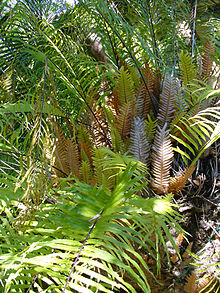Drynaria
|
Drynaria Temporal range: Piacenzian to Present |
|
|---|---|
 |
|
| Cultivated Drynaria rigidula in Florida | |
| Scientific classification | |
| Kingdom: | Plantae |
| Division: | Pteridophyta |
| Class: | Polypodiopsida/Pteridopsida (disputed) |
| Order: | Polypodiales |
| (unranked): | Eupolypods I |
| Family: | Polypodiaceae |
| Subfamily: | Polypodioideae |
| Tribe: | Drynarieae |
| Genus: |
Drynaria (Bory) J. Sm. |
| Species | |
|
See text |
|
 |
|
| Drynaria is widespread in the Old World tropics. | |
| Synonyms | |
|
|
See text
Drynaria, commonly known as basket ferns, is a genus of ferns in the family Polypodiaceae. It contains around 16 species and one natural hybrid.
Basket ferns are epiphytic or epipetric and are native to tropical Africa, South Asia, East Asia, Southeast Asia, Australia, and Oceania. Some species are economically important as medicinal plants.
Basket ferns are characterized by the presence of two types of fronds, fertile foliage fronds and sterile nest fronds. The dark green foliage fronds are large, 2–4 feet (0.61–1.22 m) long, with elongated stalks. They are deeply lobed or pinnate, winged, and bear sori (structures producing and containing spores) on the bottom surfaces.
The nest fronds are smaller rounded leaves basal to the foliage fronds. They do not bear sori and are persistent, not being shed after turning brown and dying. They form a characteristic 'basket' that collect litter and organic debris, hence the common name. The collected debris decompose into humus, providing the plants with nutrients it would otherwise not have received from being suspended above the ground.
Both frond types grow from rhizomes typically anchored to a tree or a rock. The rhizomes of Drynaria are creeping and densely covered in brown scales.
Basket ferns are epiphytic (growing on trees) or epipetric (growing on rocks). They can also sometimes be found in man-made structures like brick walls. They are found in wet tropical environments, usually in rainforests. Their native range extends from equatorial Africa to tropical South and East Asia, Southeast Asia, Australia, and Oceania.
Like other spore-bearing plants, Drynaria exhibits metagenesis or the alternation of generations. One generation being the diploid multicellular sporophyte (the phase where the plant is most familiar), and the other being the haploid multicellular gametophyte (the phase where the plant is known as a prothallus). Gametophytes develop from spores released by mature sporophytes; while sporophytes, in turn, develop from the fusion of gametes produced by mature prothalli.
...
Wikipedia
